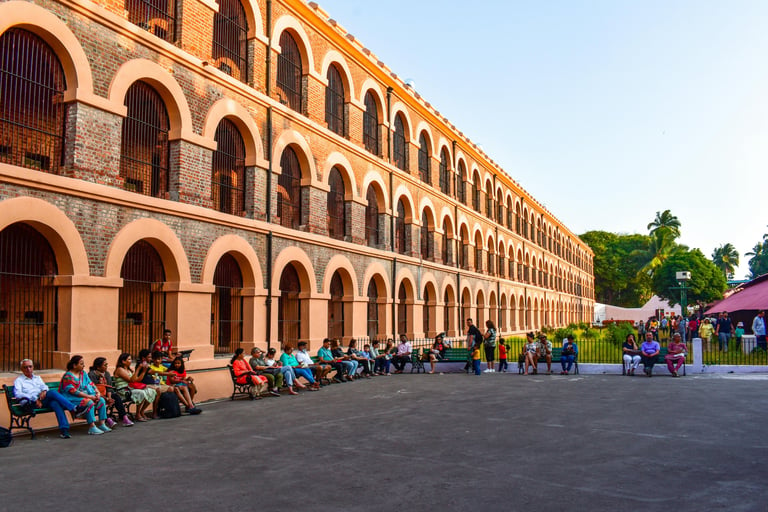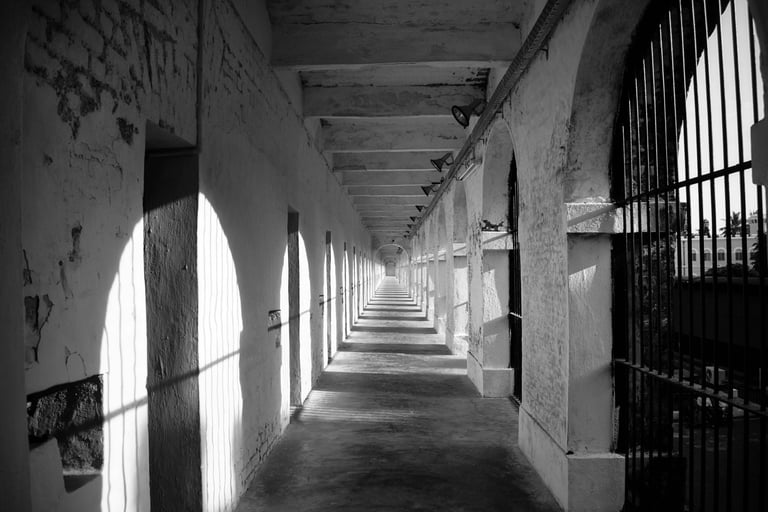The Unyielding Walls: Tales of Kala Pani
Kala Pani, where silence became a prisoner’s only voice, holds the echoes of courage that defied its walls. Each stone speaks the language of sacrifice and an undying fight for freedom.
MINDMUSE
Life Inside the Jail: Labor, Punishment, and the Daily Struggle
The life of an inmate in Kala Pani was one of unimaginable hardship. Prisoners were subjected to gruelling labour, with tasks designed to break their spirits. One of the most dreaded duties was grinding mustard seeds or coconuts to extract oil. The prisoners were made to operate the kolhu, an oil mill, often under the searing sun for hours at a stretch, working to meet impossible quotas. Failure to complete the daily labour quota led to severe punishment, ranging from lashings to solitary confinement in more brutal conditions.
The authorities also employed extreme forms of punishment, including the infamous "crossbar" torture, where prisoners were forced to remain in painful, contorted positions for hours, sometimes causing permanent injury. For the most defiant or repeat offenders, the ultimate penalty was execution by hanging, a grim reminder of the authorities' intent to crush any hope of rebellion.
In addition to the hard labour, the physical and mental strain was compounded by the oppressive isolation. Prisoners were cut off from the outside world, with no communication or even basic amenities such as toilets. They wore degrading uniforms, and food rations were barely sufficient to keep them alive. The absence of even the most basic comforts made the conditions unbearable, yet the will to resist endured in the hearts of those who were confined.
The Demolition and Preservation: A Symbol of Resistance
In 1941, the Cellular Jail suffered severe damage due to an earthquake, leading to the demolition of three of its seven wings. This natural event marked the first signs of decline for the prison, which had once served as a symbol of colonial power. However, the remaining wings of the jail stood as silent witnesses to the countless sacrifices made by India’s freedom fighters.
The call to preserve the remaining wings as a memorial was made by the Association of Ex-Andaman Political Prisoners, the Fraternity Circle, and other freedom fighter groups. Their efforts were pivotal in the movement to honour the jail as a national heritage site. In 1979, under Prime Minister Morarji Desai's leadership, the Indian government officially declared the Cellular Jail a National Memorial on February 11, 1979. This recognition preserved the site as a tribute to the resilience and sacrifices of those who had endured its horrors.
The Legacy and National Memorial Status
Today, the Cellular Jail remains an iconic site of national significance, preserving the memory of the countless freedom fighters who endured unimaginable suffering. It is a place where the past and present intersect—a poignant reminder of the sacrifices made for India's freedom. The remains of the wings, the solitary cells, and the central tower stand as an indelible testimony to the strength of the human spirit, which, despite the severe oppression, could not be broken.
The Kala Pani was intended to erase the very memory of those who suffered within its walls, but it has instead immortalized them. It stands not only as a prison of despair but as a shrine to hope, endurance, and the ultimate triumph of liberty over tyranny. When one steps inside the gates of the Cellular Jail, they walk through a living history, feeling the echoes of struggle reverberating through the very air. This place is not just a monument of the past; it is a symbol of the unbreakable resolve that made India’s freedom a reality.
The Cellular Jail was designed to silence the voices of resistance, but instead, it gave birth to an undying echo of rebellion. The brutality and isolation inflicted upon the prisoners could never extinguish the flame of independence that burned in their hearts. Today, Kala Pani stands as a sacred memorial, not only to the struggles of the past but to the eternal resilience of those who fought for the liberty that India holds today. Every cell, every broken wing, and every silent stone within the jail tells the story of a nation's unrelenting pursuit of freedom—a story that will never be forgotten.

Cellular Jail: Experience the spirit that defied oppression.




A legacy of strength that defied oppression.
Every cell holds a story of sacrifice.


Where isolation fueled the fire for freedom.
**Why It Was Called Kala Pani and Cellular Jail
The Cellular Jail was so named because of its unique design—each prisoner was confined to an isolated cell, cut off from any form of communication. The solitary confinement was intended to mentally and physically exhaust the prisoners, isolating them not only from the world but from one another. This structure itself became a powerful symbol of alienation and the brutal power of colonialism.
The term Kala Pani, meaning "Black Waters," was a colloquial expression used by the Indian people to describe the Andaman Islands, as being exiled to these distant shores was seen as a permanent severance from the rest of the world. For many, the Kala Pani was the final punishment, representing a fate worse than death—complete isolation from society and family. **
Subhalakshmi Buragohain
Hyderabad
The Cellular Jail, or Kala Pani, stands as one of India's most poignant and enduring symbols of colonial oppression and the indomitable spirit of resistance. Built by the British in the Andaman Islands between 1896 and 1906, this notorious prison was designed not only to confine but to break the bodies and spirits of India's freedom fighters. However, the jail itself became a testament to resilience, its very existence highlighting the struggle for India's independence.
Origins and Design: The Birth of the Cellular Jail
The Cellular Jail was conceived by British officials C.J. Lyall and Major Lethbridge, who proposed the Andaman Islands as an ideal location for a high-security prison. The idea was to isolate the most dangerous political prisoners, preventing them from influencing or organizing resistance movements. The term Kala Pani, or “Black Waters,” symbolized the remoteness of the place—a desolate expanse of ocean that rendered escape near impossible and, in the Indian consciousness, meant total exile and severance from family and homeland.
The jail’s design was a deliberate architectural manifestation of isolation. It featured seven wings radiating from a central tower, resembling the shape of a star. Each wing contained solitary cells that housed prisoners in complete isolation from one another. The structure’s layout allowed the guards, stationed in the central tower, to observe every movement, ensuring that the prisoners had no contact or means of communication with one another.
Initially planned as a two-story structure, the design was later modified into a three-story building to accommodate 663 solitary cells. Each cell was small, measuring just 13.5 feet by 7 feet, secured by heavy iron doors with intricate latches. The construction materials were imported from England, Burma, and India, and local labourers, many of whom were prisoners themselves, worked tirelessly to build the imposing structure. The British also made provisions for earthquake resistance, anticipating the seismic activity common in the region. Despite these precautions, the jail was not immune to nature’s forces.
